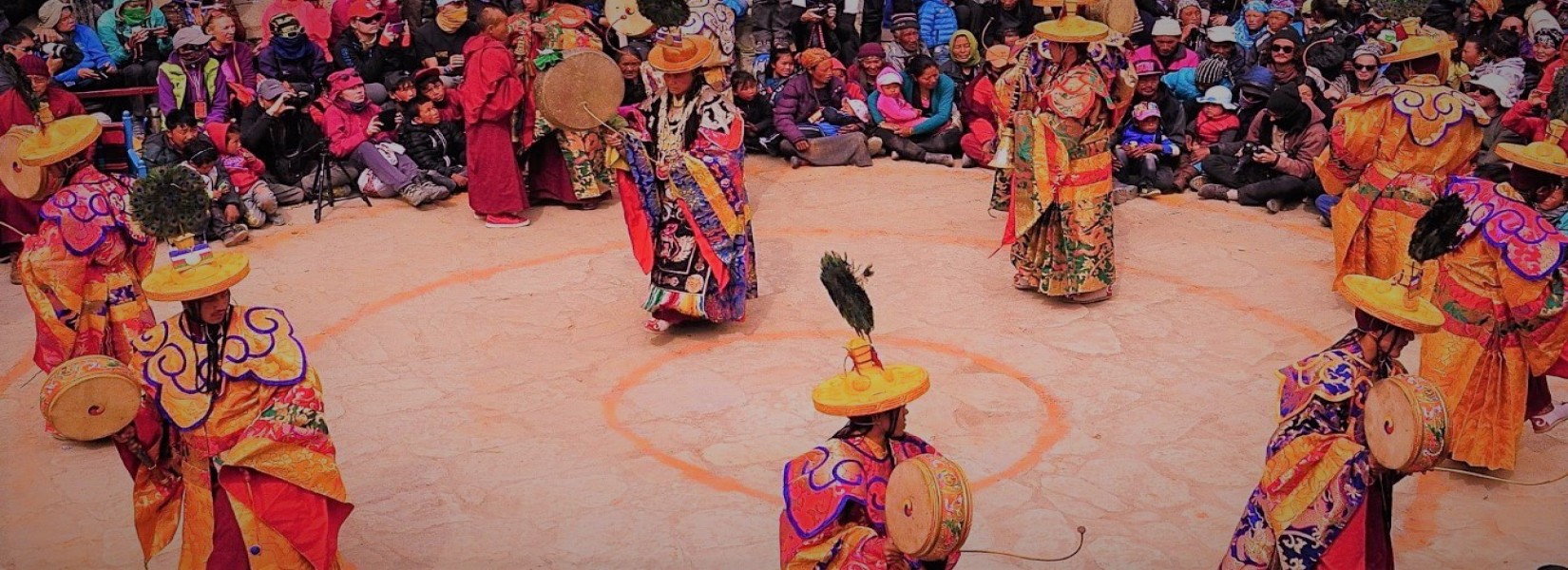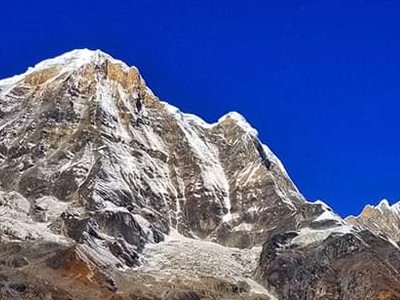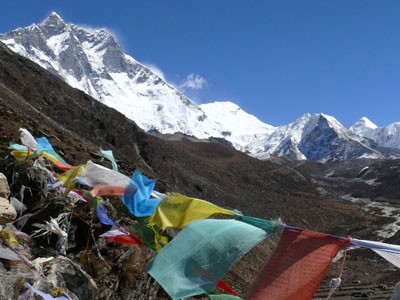Tiji Festival, also known as the "Tenzing Tiji Festival," emerges as an annual oasis of tradition, spirituality, and cultural splendor in the remote Lo Manthang region of Upper Mustang, Nepal. Far removed from the bustling modern world, this sacred festival transcends time, offering a profound glimpse into the intricate tapestry of Tibetan Buddhist heritage that has been woven into the very fabric of this isolated community.
"Celebrate the Tiji Festival with Nepal Spirit Adventure".
With its origins tracing back to the 17th century, the Tiji Festival stands not only as a religious event but also as a vibrant display of history, artistry, and the enduring resilience of a people deeply connected to their land and beliefs.
As the festival's spiritual and cultural nucleus, Lo Manthang becomes a bustling center of activity during the Tiji celebrations. Locals from surrounding villages, as well as curious travelers from across the globe, converge here to partake in the festivities. The city's monasteries, including the Chhode Monastery, play a pivotal role in hosting the religious ceremonies and sacred dances that constitute the essence of the Tiji Festival. These monastic spaces, echoing with the chants of monks and resonating with the thumping beats of traditional instruments, create an atmosphere steeped in devotion and reverence.
About Lo Manthang
Nestled amidst the breathtaking landscapes of Upper Mustang, Nepal, Lo Manthang is a place where time seems to stand still, and the essence of ancient Tibetan Buddhist culture thrives. This walled city, often referred to as the "Forbidden Kingdom," holds a profound significance as the epicenter of the Tiji Festival, an annual celebration that encapsulates the region's rich history, spirituality, and communal bonds.
Lo Manthang's historical importance is deeply intertwined with the Tiji Festival, which finds its roots in the legends and traditions of this remote land. The city's very layout and architecture bear witness to its historical connection with the festival. Enclosed within its centuries-old walls, Lo Manthang's labyrinthine streets and traditional buildings become the stage upon which the intricate rituals and vibrant dances of the Tiji Festival unfold.
Tiji Festival: Historical Origins and Symbolism:
The origins of the Tiji Festival can be traced back to the 17th century, a time when the Mustang region was ruled by its own kings who held both secular and spiritual authority. The festival is rooted in a religious narrative that centers around the victory of the deity Dorje Jono over a demon called Ma Tam Ru Ta. This narrative symbolizes the triumph of good over evil and underscores the importance of protecting the community from negative forces.
Dates and Lunar Calendar: Tiji Festival
The Tiji Festival is typically celebrated over the course of three days, falling on dates in either May or June. The exact timing is determined by the Tibetan lunar calendar, which is based on both the moon's phases and astrological considerations. The festival's timing varies from year to year, adding an element of unpredictability and excitement to the event.
The Tiji festival will be celebrated on the English dates of 5th, 6th, and 7th May of 2024 in the Upper Mustang. In the year 2025, Tiji will be celebrated on the 24th, 25th, and 26th of May.
Rituals and Ceremonies of the Tiji Festival
The Tiji Festival is characterized by a series of elaborate rituals and ceremonies performed by Buddhist monks from the local monastery, as well as monks from neighboring areas. The festival unfolds over three major days of ritual, dance, and spiritual devotion. These days, each marked by its distinct ceremonies and symbolic significance, bring together the local community and visitors alike in a shared experience of culture and spirituality.
Also, these rituals are conducted with meticulous attention to detail and are deeply steeped in religious significance. The primary rituals and ceremonies include:
Day 1: The Unveiling of the Thangka
The festival commences with a palpable sense of anticipation as the massive Thangka, a sacred religious painting, is unveiled. This momentous event takes place in the courtyard of the Chhode Monastery in Lo Manthang. The Thangka, an intricately painted depiction of the deity Dorje Jono, acts as a visual representation of the divine presence that will guide the proceedings of the festival.
The unveiling ceremony is a solemn affair, with monks chanting prayers and performing rituals that invite the deity's blessings for the days ahead. As the Thangka is revealed, a collective gasp of awe and reverence sweeps through the assembled crowd, setting the tone for the rest of the festival.
Day 2: The Dance of Good Triumphing over Evil
The second day of the Tiji Festival is marked by a series of dynamic masked dances, collectively known as the "Chhode" dances. These dances are a vivid reenactment of the mythical battle between the deity Dorje Jono and the demon Ma Tam Ru Ta. Each dance represents a distinct episode of the battle, symbolizing various stages of conflict and the eventual victory of good over evil.
Elaborate masks and costumes, meticulously crafted to represent deities, demons, animals, and other symbolic figures, transform the dancers into embodiments of the cosmic struggle.
The Chhode dances are characterized by intricate choreography and rhythmic movements that resonate with both spiritual and artistic significance. Accompanied by the melodious sounds of traditional instruments, the dancers bring to life a timeless narrative, captivating the audience and carrying them on a journey through the realms of mythology and faith.
Day 3: Rituals, Offerings, and Benedictions
The final day of the Tiji Festival is a culmination of devotion, rituals, and blessings. Monks gather in the monastery to perform ceremonies that seek to dispel negativity, ensure prosperity, and offer gratitude for the triumph of good.
The chanting of prayers, the offering of sacred items, and the lighting of butter lamps create an atmosphere of spiritual serenity. The festival concludes with the "Rha Jha Tsegu" ceremony, during which the remaining portions of the Thangka are displayed to the public, bestowing blessings upon all who witness it.
As the sun sets on the third day, the Tiji Festival draws to a close, leaving behind a sense of fulfillment and a renewed connection to spirituality and community. The festival's impact lingers long after the celebrations, as its symbolism and teachings continue to resonate in the lives of those who have partaken in this extraordinary journey.
On these three major days, the Tiji Festival encapsulates the essence of Upper Mustang's cultural identity, showcasing the profound interplay between tradition, artistry, and spiritual devotion. It's a testament to the timeless power of rituals and the enduring relevance of stories that bridge the gap between the earthly and the divine.
Cultural Significance and Community Gathering:
Beyond its religious import, the Tiji Festival serves as a significant cultural event that brings together the entire community. It's a time when families reunite, neighbors share stories, and people from different villages interact. The festival reinforces a sense of shared identity and belonging among the local people, fostering a strong sense of community.
Tourism and Conservation Concerns:
In recent years, the Tiji Festival has garnered attention from tourists, scholars, and adventure seekers. While tourism can provide economic opportunities for the region, it also poses challenges. The influx of visitors can disrupt the delicate balance of the local ecosystem and culture. Efforts are being made to strike a harmonious balance between preserving the cultural authenticity of the festival and protecting the environment.
Preservation of Tradition:
The Tiji Festival stands as a testament to the resilience of traditional practices in the face of modernization and changing times. It serves as a means of passing down cultural and religious knowledge from one generation to the next. The festival plays a crucial role in preserving the distinct identity of the Mustang region and its people.
Tiji Festival Tour with Nepal Spirit Adventure
As a pioneering travel company deeply committed to preserving and sharing Nepal's rich heritage, we take immense pride in organizing the Tiji Festival experience year after year. Nepal Spirit Adventure invites you to witness the Tiji Festival in all its glory. Our meticulously crafted itineraries offer a front-row seat to this ancient celebration, allowing you to delve into the heart of Upper Mustang's traditions and history.
With a deep respect for the local culture, we provide an authentic experience that brings you face-to-face with the spiritual fervor and artistic brilliance that define the festival. Backed by a team of seasoned professionals and local experts, Nepal Spirit Adventure ensures that every aspect of your Tiji Festival journey is meticulously planned and flawlessly executed.
At Nepal Spirit Adventure, we believe in responsible and ethical tourism. Our partnerships with local communities ensure that your participation in the Tiji Festival is not only enriching for you but also beneficial for the people and places you visit. We work hand in hand with the local inhabitants, fostering meaningful cultural exchanges that leave a positive impact. Explore ancient monasteries, traverse breathtaking landscapes, and engage with warm-hearted locals who welcome you into their world with open arms.




